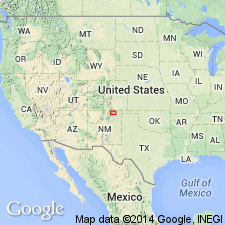
- Usage in publication:
-
- Yankee coal bed*
- Modifications:
-
- First used
- Dominant lithology:
-
- Coal
- AAPG geologic province:
-
- Las Vegas-Raton basin
Summary:
First use of name; intent to name not stated, and no type locality designated. Probably named for town of Yankee, Colfax Co, NM, Las Vegas-Raton basin. Occurs near the eastern limit of Raton coal field, where it is a coal bed in Raton Formation. Is located in the upper, coal-bearing division of three field divisions of Raton Formation. Raton Formation is overlain by Paleocene Poison Canyon Formation, and overlies Late Cretaceous Vermejo Formation--Vermejo conformably overlies Trinidad Sandstone but is locally absent beneath the base of overlying Raton Formation. The Yankee is only 300-400 ft above the Trinidad Sandstone, indicating either that the lower division of Raton thins significantly a short distance from the Tin Pan area in the east, or that coal beds occur lower in Raton Formation than they do farther to the west. Yankee is thinner and less extensive than the other beds in the area, and underlies a number of other coal beds scattered throughout the coal-bearing division of Raton; Yankee is at the base of the division. Possibly equivalent to one of the other beds, but outcrops are obscured and tracing of beds on ground nearly impossible. Like most of the coal beds, Yankee contains shale partings. Is of Paleocene age.
Source: GNU records (USGS DDS-6; Denver GNULEX).
For more information, please contact Nancy Stamm, Geologic Names Committee Secretary.
Asterisk (*) indicates published by U.S. Geological Survey authors.
"No current usage" (†) implies that a name has been abandoned or has fallen into disuse. Former usage and, if known, replacement name given in parentheses ( ).
Slash (/) indicates name conflicts with nomenclatural guidelines (CSN, 1933; ACSN, 1961, 1970; NACSN, 1983, 2005, 2021). May be explained within brackets ([ ]).

